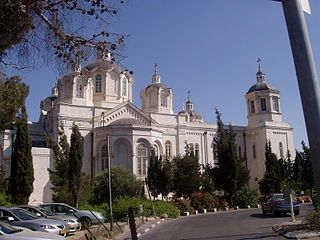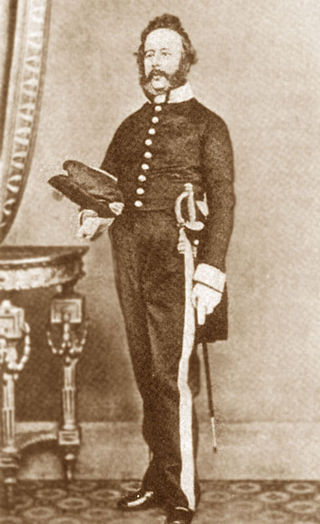
Jerusalem's population size and composition has shifted many times over its 5,000 year history.

Mishkenot Sha'ananim was the first Jewish settlement built outside the walls of the Old City of Jerusalem, on a hill directly across Mount Zion. It was built in 1859–1860. This guesthouse was one of the first structures to be built outside the Old City, the others being Kerem Avraham, the Schneller Orphanage, Bishop Gobat school, and the Russian Compound.

The perushim were Jewish disciples of the Vilna Gaon, Elijah ben Solomon Zalman, who left Lithuania at the beginning of the 19th century to settle in the Land of Israel, which was then part of Ottoman Syria. They were from the section of the community known as misnagdim in Lithuania.

The Russian Compound is one of the oldest districts in central Jerusalem, featuring a large Russian Orthodox church, the Russian-owned Sergei's Courtyard and the premises of the Russian Consulate General in Jerusalem, as well as the site of former pilgrim hostels, some of which are used as Israeli government buildings, and one of which hosts the Museum of Underground Prisoners. The compound was built between 1860 and 1890, with the addition in 1903 of the Nikolai Pilgrims Hospice. It was one of the first structures to be built outside the Old City of Jerusalem. The Bezalel Academy of Arts and Design's main campus is adjacent to the compound.

Yemin Moshe is a historic neighborhood in Jerusalem, overlooking the Old City.

Jerusalem University College is an independent undergraduate and graduate academic institution in Israel used by a consortium of North American theological seminaries and Christian colleges.

James Finn (1806–1872) was a British Consul in Jerusalem, in the then Ottoman Empire (1846–1863).

Geula is a neighborhood in the center of Jerusalem, populated mainly by Haredi Jews. Geula is bordered by Zikhron Moshe and Mekor Baruch on the west, the Bukharim neighborhood on the north, Mea Shearim on the east and the Jerusalem city center on the south.

Elizabeth Anne Finn (1825–1921) was a British writer and the wife of James Finn, British Consul in Jerusalem, in Ottoman Palestine between 1846 and 1863. She and her daughter co-founded the Distressed Gentlefolk's Aid Association, the predecessor of Elizabeth Finn Care.
The Old Yishuv were the Jewish communities of the region of Palestine during the Ottoman period, up to the onset of Zionist aliyah and the consolidation of the New Yishuv by the end of World War I. In the late 19th century, the Old Yishuv comprised 0.3% of the world's Jews, representing 2–5% of the population of the Palestine region.
Kollel Shomrei haChomos is a financial charity institute or kollel set up to support the community of Hungarian-Jews who emigrated to the Holy Land, hence it is called by many the Hungarian Kollel. The Hungarian Jews separated themselves in 1858 from its mother institute Kolel Chibas Yerushalayim which at one point in time included the Jewish communities of the entire Austrian Hungarian Kingdom. Kolel Chibas Yerushalayim was itself a breakaway from the original Kolel Perushim, established by the students of the Vilna Gaon. Two leading Hungarian rabbis were appointed as the "Nesyim" or "Presidents of the Kolel, Avraham Shmuel Binyamin Sofer, author of Ketav Sofer, and Meir Eisenstein. In honor of these two leaders the Hungarian Kolel was also called "House of Sofer and Meir"

The Montefiore Windmill is a landmark windmill in Jerusalem. Designed as a flour mill, it was built in 1857 on a slope opposite the western city walls of Jerusalem, where three years later the new Jewish neighbourhood of Mishkenot Sha'ananim was erected, both by the efforts of British Jewish banker and philanthropist Moses Montefiore. Jerusalem at the time was part of Ottoman-ruled Palestine. Today the windmill serves as a small museum dedicated to the achievements of Montefiore. It was restored in 2012 with a new cap and sails in the style of the originals. The mill can turn in the wind.

Schneller Orphanage, also called the Syrian Orphanage, was a German Protestant orphanage that operated in Jerusalem from 1860 to 1940.
Avraham Wolfensohn (1783–1855) was a Jewish rabbi, Talmudic judge and leader of the Ashkenazi community in Safed, Ottoman Galilee in the mid-19th century.

The expansion of Jerusalem outside of the Old City walls, which included shifting the city center to the new neighborhoods, started in the mid-19th century and by the early 20th century had entirely transformed the city. Prior to the 19th century, the main built up areas outside the walls were the complex around King David's Tomb on the southern Mount Zion, and the village of Silwan.

Sir Moses Haim Montefiore, 1st Baronet, was a British financier and banker, activist, philanthropist and Sheriff of London. Born to an Italian Sephardic Jewish family based in London, after he achieved success, he donated large sums of money to promote industry, business, economic development, education and health among the Jewish community in the Levant. He founded Mishkenot Sha'ananim in 1860, the first Jewish settlement outside the Old City of Jerusalem.

Malkhei Yisrael Street, also spelled Malchei Yisrael, is an east–west street in the Geula neighborhood of north-central Jerusalem. Its eastern flank, which abuts Mea Shearim Street at an intersection called Kikar HaShabbat, is the main shopping district for Haredi Jewish residents of northern Jerusalem. The remainder of the street, which extends to Sarei Yisrael Street at its western end, includes the historic Schneller Compound and numerous Haredi and Hasidic yeshivas, girls' schools, and synagogues.

Avraham Al-Naddaf (1866–1940), the son of Ḥayim b. Salem Al-Naddaf, was a Yemenite rabbi and scholar who immigrated to Ottoman Palestine in 1891, eventually becoming one of the members of the Yemenite rabbinical court (Beit-Din) established in Jerusalem in 1908, and active in public affairs. His maternal grandfather was Rabbi Yiḥya Badiḥi (1803–1887), the renowned sage and author of the Questions & Responsa, Ḥen Ṭov, and a commentary on the laws of ritual slaughter of livestock, Leḥem Todah, who served as the head of Sanaa's largest seat of learning (yeshiva), held in the synagogue, Bayt Saleḥ, before he was forced to flee from Sana'a in 1846 on account of the tyrant, Abū-Zayid b. Ḥasan al-Miṣrī, who persecuted the Jews under the Imam Al-Mutawakkil Muhammad.

The bronze bust of former British prime minister Sir Winston Churchill at Mishkenot Sha’ananim, Jerusalem was created by portrait sculptor Oscar Nemon. Anthony Rosenfelder, together with MK Isaac Herzog, initiated the process of erecting the bust of Churchill in Jerusalem.
Aaron Hershler was a Hungarian-born Jew considered the first national Jewish martyr in the Jewish-Arab conflict. While attempting to intervene in a robbery at his family's home in Mishkenot Sha'ananim, the first Jewish neighborhood outside the walls of the Old City of Jerusalem, Hershler was shot 12 times, dying 5 days later.


















